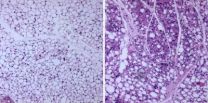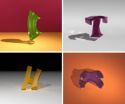(Press-News.org) CORVALLIS, Ore. – Researchers have taken a new look at an old, but seldom-used technique developed by the petroleum industry to recover oil, and learned more about why it works, how it could be improved, and how it might be able to make a comeback not only in oil recovery but also environmental cleanup.
The technology, called "microbial enhanced oil recovery," was first developed decades ago, but oil drillers largely lost interest in it due to its cost, inconsistent results and a poor understanding of what was actually happening underground.
The new findings by engineers at Oregon State University, published in the Journal of Petroleum Science and Engineering, could help change that. This may allow the oil industry not only to produce more oil from their existing wells, but also find applications in cleaning up petroleum spills and contaminants.
"This approach of using microbes to increase oil recovery was used somewhat in the 1980s when oil prices were very high, but the field results weren't very consistent and it was expensive," said Dorthe Wildenschild, an associate professor in the OSU School of Chemical, Biological and Environmental Engineering. "It's seldom used now as a result."
Oil drilling has always been difficult – it's not as simple as drilling a hole and watching the petroleum gush out of the ground.
That may happen for a while, but as a secondary step, water is often injected into the well to help flush out more oil. Such production techniques generally recover only one-third to one-half of the oil originally present in a reservoir.
A third approach sometimes used after water injection is to inject microbes into the well and "feed" them with sugars such as molasses to encourage their growth. This can clog some pores and in others has a "surfactant" effect, loosening the oil from the surface it clings to, much as a dishwasher detergent loosens grease from a pan.
"By clogging up some pores and helping oil move more easily through others, these approaches can in theory be used with water flushing to help recover quite a bit more oil," Wildenschild said.
The surfactant can be man-made, or microbes can be used to produce it at a lower cost. However, getting a particular culture of microbes to produce the biosurfactant under harsh field conditions is tricky.
"It's complicated, you have to use just the right microbes, and feed them just the right foods, to accomplish what you want to do," Wildenschild said.
In OSU laboratory experiments, Ryan Armstrong, a recent doctoral graduate at OSU, found that the clogging mechanism is the simplest and most effective approach to use, although combining it with the biosurfactant technology achieved optimal oil recovery.
A better fundamental understanding of this process – along with higher oil prices that better reward efforts to recover more oil – could lead to renewed interest in the technology on a commercial basis, the OSU researchers said, and make oil recovery more productive. As an extra benefit, the concepts might also work well to help remove or clean up underground contaminants, they said.
INFORMATION:This work was supported by the Petroleum Research Fund of the American Chemical Society.
Editor's Note: A digital image demonstrating improved oil recovery is available online: http://bit.ly/QfX2VV
AUDIO:
Researchers at Washington University School of Medicine in St. Louis have identified a potential target for treating diabetes and obesity. They discovered that when a particular protein is disabled in...
Click here for more information.
Researchers at Washington University School of Medicine in St. Louis have identified a potential target for treating diabetes and obesity.
Studying mice, they found that when the target protein was disabled, the animals became more ...
There's a passage in the Old Testament's Deuteronomy that says if a case too difficult to decide comes before the courts, it should be brought to the Levite priests who will render a verdict in God's name. However, one University of Alberta researcher says that may be taking religious freedom a step too far.
Sarah Hamill, a doctoral student in the Faculty of Law, recently published an article in response to a premise that said judges who lack direction-setting precedence in cases should use religious-based reasoning. Hamill contends that—aside from being a serious breach ...
KINGSTON, R.I. – August 2, 2012 – A postdoctoral researcher at the University of Rhode Island has observed a never-before-seen defensive strategy used by a small species of deep-sea squid in which the animal counter-attacks a predator and then leaves the tips of its arms attached to the predator as a distraction.
Stephanie Bush said that when the foot-long octopus squid (Octopoteuthis deletron) found deep in the northeast Pacific Ocean "jettisons its arms" in self-defense, the bioluminescent tips continue to twitch and glow, creating a diversion that enables the squid ...
In science fiction novels, evil overlords and hostile aliens often threaten to vaporize the Earth. At the beginning of The Hitchhikers Guide to the Galaxy, the officiously bureaucratic aliens called Vogons, authors of the third-worst poetry in the universe, actually follow through on the threat, destroying the Earth to make way for a hyperspatial express route.
"We scientists are not content just to talk about vaporizing the Earth," says Bruce Fegley, professor of earth and planetary sciences at Washington University in St. Louis, tongue firmly in cheek. "We want to understand ...
Last year, astronomers discovered a quiescent black hole in a distant galaxy that erupted after shredding and consuming a passing star. Now researchers have identified a distinctive X-ray signal observed in the days following the outburst that comes from matter on the verge of falling into the black hole.
This tell-tale signal, called a quasi-periodic oscillation or QPO, is a characteristic feature of the accretion disks that often surround the most compact objects in the universe -- white dwarf stars, neutron stars and black holes. QPOs have been seen in many stellar-mass ...
Durham, NC – What makes some species more prone to extinction? A new study of nearly 300 species of New Zealand birds — from pre-human times to the present — reveals that the keys to survival today differ from those of the past.
The results are important in light of the growing number of studies that try to predict which species could be lost in the future based on what kinds of species are considered most threatened today, said lead author Lindell Bromham of Australian National University.
In the roughly 700 years since humans arrived in the remote islands that make ...
Jeanne Romero-Severson, associate professor of biological sciences at the University of Notre Dame, and her collaborators, are tracking the evolution of the live oaks of eastern North America, seeking to understand how the trees adapted to climate change during glacial periods.
When the ice advanced, the oaks retreated. When the ice retreated the oaks advanced, spreading from tropical to temperate zones, up from Central America and Mexico into the Piedmont Carolinas. The researchers expect the study of live oak migrations and phylogeny will provide clues to the success ...
Computer-generated characters have become so lifelike in appearance and movement that the line separating reality is almost imperceptible at times. "The Matrix" sequels messed with audiences' perceptions of reality (in more ways than one) with action scenes mixing CG characters and real actors. Almost a decade later, superheroes and alien warriors dominate the multiplex. But while bipeds and quadrupeds have reigned supreme in CG animation, attempts to create and control their skeleton-free cousins using similar techniques has proved time-consuming and laborious.
Georgia ...
On the classic TV show "I Love Lucy," Ricky Ricardo was known for switching into rapid-fire Spanish whenever he was upset, despite the fact Lucy had no idea what her Cuban husband was saying. These scenes were comedy gold, but they also provided a relatable portrayal of the linguistic phenomenon of code-switching.
This kind of code-switching, or switching back and forth between different languages, happens all the time in multilingual environments, and often in emotional situations. In a new article in the July issue of Perspectives on Psychological Science, a journal ...
CHAPEL HILL, N.C. -- Treating chronic venous leg ulcers with a topical spray containing a unique living human cell formula provides a 52 percent greater likelihood of wound closure than treatment with compression bandages only.
That's the conclusion of a new study conducted in part at the University of North Carolina School of Medicine and published online by The Lancet this week.
The Phase II clinical trial, which investigates the efficacy of HP802-247 from Healthpoint® Biotherapeutics, was designed to determine effectiveness of certain cell concentrations and dosing ...



